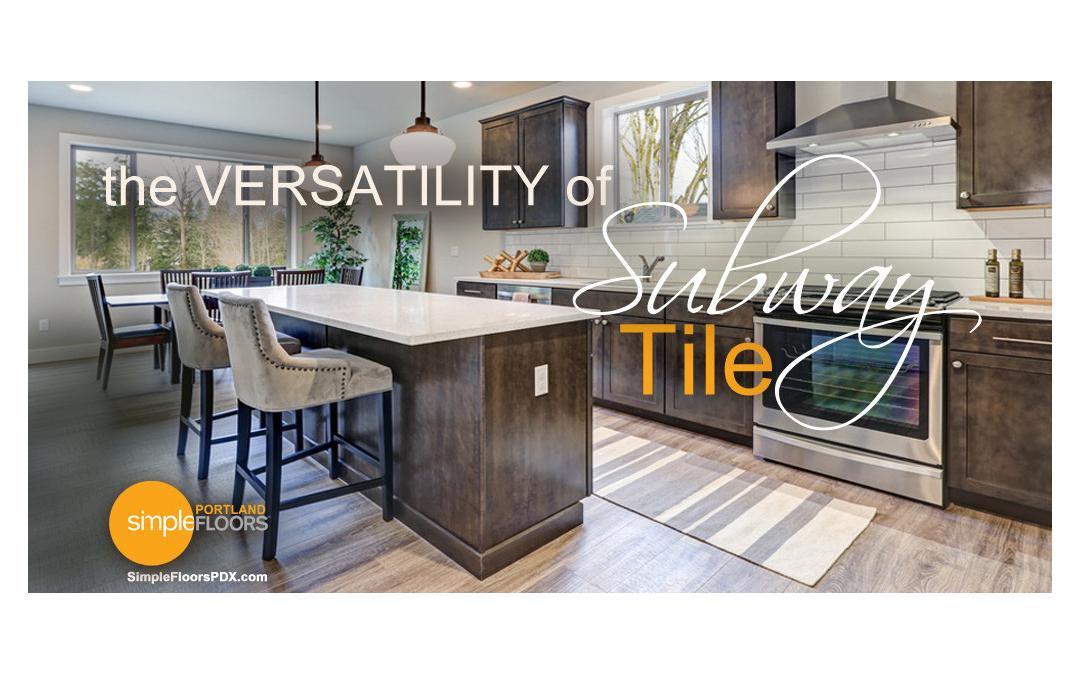The subway tile is one of America’s most storied design options for kitchens and bathrooms alike. Chances are, a quick tour throughout your home, just might reveal this classic look being featured within your four walls. Subway tile is extremely versatile and provides unlimited opportunities for adding interest, design and character to a space.
But, why are they called subway tiles?
How Did The Subway Tile Get Its Name?
What are subway tiles? For some, the subway tile might just be a simple name that is used to describe a certain item or look due to it reminding them of something similar. However, at a closer look, subway tiles have a historical significance here in America. You see, on October 27, 1904, the first rapid transit subway opened in New York City. At 7pm that evening, the subway opened to the public. Paying a nickel each for their first ride, a 100,000 people got in line. From there, the New York subway system became the largest in America.
For the interior design of this brand-new subway, distinct 3”x6” rectangle tiles were created by designers George C. Heins and Christopher Grant La Forge in order to provide a unique look and feel to its very first subway station, which was New York’s old City Hall. With vaulted ceilings, arches, skylights, and brass chandeliers, the new subway tiling was the perfect look to bring together the sheer elegance of the experience.
In the book, “722 Miles: The Building of The Subways”, Clifton Hood describes opening night:
“The night took on a carnival atmosphere, like New Year’s Eve. Many couples celebrated in style by putting on their best clothes, going out to dinner, and then taking their first subway ride together. Some people spent the entire evening on the trains, going back and forth from 145th street to City Hall for hours.”
New Yorker’s so enjoyed the subway experience that they later coined the phrase, “doing the subway.”
Subway Tile Has Benefits
What were some benefits to using tile? Being that tile is relatively easy to clean, it made for a perfect design solution for this new subway station, which before the perhaps rat-infested and dirt filled perceptions we may have today of the subway, was a night out on the town. The Victorians were obsessed with hygiene, therefore easy to clean subway tile made the perfect sense.
Another benefit to using these tiles in the design is that they also brought the reflection of light to the subterranean stations.
Following its debut at New York’s old City Hall station, the subway tile began to appear in all types of interiors within homes and businesses alike.
Fast forward over a century later and the classic subway tile remains a staple in many bathrooms, kitchens, for a backsplash and in other spaces to create a timeless, clean look and feel. Though the subway tile has evolved to a more common 4”x4” square, as seen in many modern subways, to this day the standard 3”x6” subway tile remains a wildly popular choice for its classic appeal and home design versatility.
What Type Of Subway Tile Is Best For You?
Ceramic vs Porcelain
What are the basic subway tile styles? Subway tile has come a long way since its ceramic beginnings in the subway station. You can now find subway tile that is also porcelain, glass, cement, marble, and even stone. However, the most common subway tile materials are ceramic subway tile and porcelain subway tile.
A Commonly Asked Question About Subway Tile Materials
What’s the difference between porcelain and ceramic tile? This is a question that is asked frequently when people are trying to decide between the two most popular types of tile material. Here are just a few of the differences, along with some recommendations:
Ceramic tile – If you are on a tight budget, ceramic is probably going to be the better option. Also, if you are a DIY pro, ceramic is going to be much easier to cut and install than porcelain will be. But fear not, if you’re worried about losing style for budget, fortunately, there are many options for ceramic tile the look and feel of current industry trends.
Porcelain tile – Though ceramic tiles remain a popular choice for installation in bathrooms and showers, if you’re looking to install subway tile in areas which experience high moisture, porcelain as a tile, absorbs considerably less which makes it essentially waterproof. Not that ceramic is a bad choice, but when you review the two, porcelain would certainly be the better of the two. Another area where porcelain excels is in areas of high foot traffic. Ceramic is a good choice for use in such areas, but due to porcelain being a much denser tile, it then provides more long-term resistance to everyday wear and tear.
Subway Tile Provides Versatility In Design & Patterns
What are basic subway tile installation patterns? Subway tile provides for virtually unlimited design opportunities that can take any space from traditional to trendy, depending on the look and feel you are after. From a backsplash with flair or an accent wall for some personality, all the way to simple clean and classic looking bathroom walls, or even used for an impactful countertop, here are three of the most popular patterns for installing subway tile.
Brick Pattern – Hearkening back to its initial subway station look, this classic layout is called a running bond where the tile is laid like bricks. Often, you will see this installation pattern with a diagonal orientation or a simple vertical layout anywhere from 45 to 90 degrees. You can also stack the tiles with the grout lines running straight up the wall providing more of a modern feel.
Herringbone Pattern – This popular subway tile pattern can be implemented with different variations. From kitchen backsplashes to bathroom showers, the traditional, straight, and diagonal patterns add a distinction of elegance. With this pattern, it is essentially an L shape using two tiles that nestle next to each other and then is repeated.
Basket Weave Pattern – This increasingly popular pattern turns subway tiles into square units to create a woven appearance. This style can be modern, transitional, and traditional. A popular use for the basket weave layout would be to add a touch of flare to contemporary decor.
Using subway tile as a base design element across various spaces within your home design plan can provide you with impactful and versatile design opportunities that can brighten up any space. Subway tile can also give you a classic look and feel that is sure to accent any room with a touch of contrast that is still relatively easy to clean.
Here are 4 ideas to consider for using subway tile in your home:
- Add a sense of more space to smaller rooms by utilizing subway tiles in various patterns.
- Add a touch of flare and character by accenting a wall with subway tiles.
- Add contrast to your kitchen appliances and color scheme with unique backsplash pattern and color.
- Add a touch of differentiation with accenting borders with subway tile.
How can we help you decide on the perfect subway tile for your home design project?










Thank you for the detailed explanation of subway tiles. It’s interesting to see how a design from New York’s subway has become a popular choice in homes today. The comparison between ceramic and porcelain tiles was helpful, especially for those looking to choose the right material. The different installation patterns, like herringbone and brick, offer great ideas for adding style to any space. I appreciate the tips on using subway tiles to enhance a room’s design they’re very useful!
Subway tiles offer a timeless, versatile design that elevates any space with elegance. Their classic appeal and easy maintenance make them a great choice for both modern and traditional interiors.